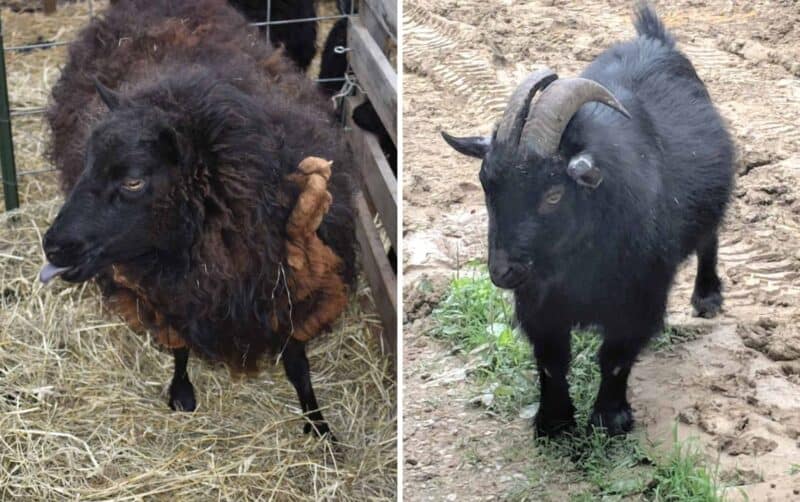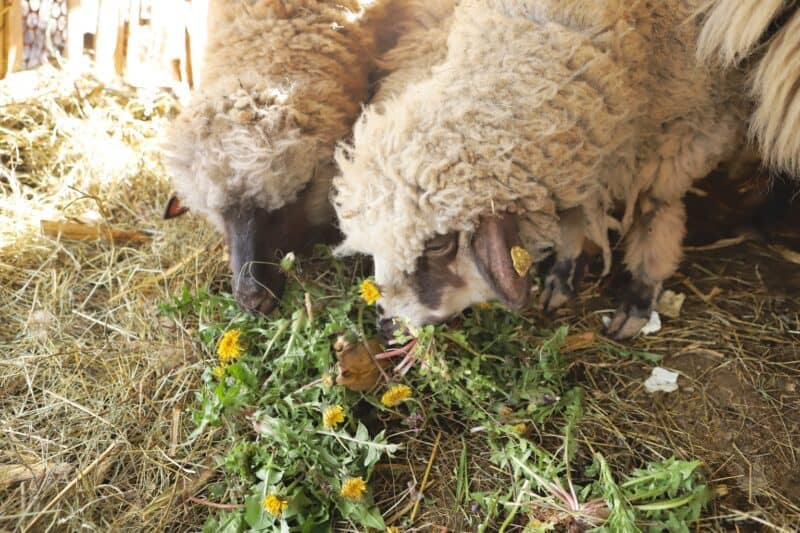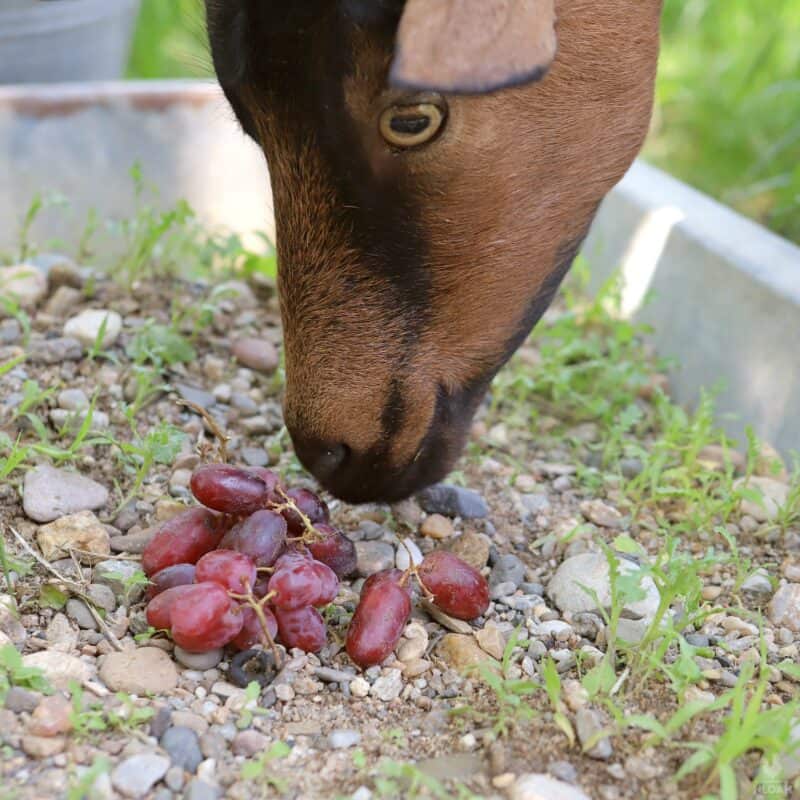It’s often asked if sheep and goats are related, given their physical similarities. About the same build, the same freaky rectangular pupils, similar diets, and so on.

You’d be forgiven for thinking that sheep are just wooly goats, honestly!
But sometimes even the most similar things can be different at a basic level. So, what’s the real story? Are sheep and goats related?
Yes, sheep and goats are related. Both sheep and goats belong to the family Bovidae and subfamily Caprinae. However, they diverge genetically at the genus level, with sheep belonging to the genus Ovis and goats belonging to the genus Capra.
And that’s really all there is to it when you get down to the nitty gritty: Sheep and goats are related, closely in the grand scheme of things. But there are still many differences between them.
In order to further understand how these two animals are connected through genetics yet different in so many ways, we’ll need to take a closer look at each species’ characteristics.
Keep reading and I’ll tell you more…
What are the Basic Differences Between Sheep and Goats?
| Feature | Sheep | Goat |
|---|---|---|
| Scientific name | Ovis aries | Capra aegagrus hircus |
| Flock | Prefer to flock more | Prefer to flock less |
| Average lifespan | 10 – 12 years | 6 – 10 years |
| Horns | Yes, in both males and females | Yes, in both males and females |
| Free-ranging behavior | They are grazers | They are browsers |
| Stomach | 4-chambered stomach | 2-chambered stomach |
| Wool? | Yes | No |
| Milk production | Lower milk production | Higher milk production |
| Noise level | Quieter | Noisier |
| Tail | Thicker and longer | Thinner and shorter |
| Forehead | Wider | Narrower |
Although sheep and goats are related, they have distinct differences. Sheep have typically curly, woolly coats, and are usually larger than goats.
In contrast, goats have straighter and shorter hair and are relatively smaller than sheep.
Sheep also have a thicker tail than goats. The tail of a sheep is naturally longer than that of most goats, and requires docking in many cases.
Sheep are also classed as grazers, animals that prefer to eat their primary food source, grass, steadily.
Goats, on the other hand, are browsers which means they move around more often looking for new food sources and choice bits from a variety of things like plants, shrubs and trees.

What Defines a Sheep?
Domestic sheep, scientific name Ovis aries, are typically kept as livestock and used for their wool, meat, and hides.
These animals are best known for their woolly coats which is harvested and used for clothing, carpets, and other textile products.
A sheep’s average lifespan is 10-12 years, and its wool, or fleece, coat can weigh over 24 pounds.
Sheep are highly social and gregarious animals, and prefer to live in groups called flocks which are closely coordinated and communal. They are herbivores and graze on grass as a staple food.

What Defines a Goat?
Domestic goats, scientific name Capra aegagrus hircus, are typically kept for their milk, meat, hides and sometimes for their fur or hair.
The average lifespan of a goat is 6-10 years. Goats are known to be intelligent and curious animals that like to climb and explore the environment around them.
They’re also social animals and prefer to live in herds, although they do not form the same tight-knit relationships as sheep with each member acting as a part of a larger whole- very much more an assembly of individuals you might say.
Goats are primarily browsers who feed on a variety of plants, shrubs, and trees, but also on grass.
Physical Differences between Goats and Sheep
Goats and sheep look similar, but have distinct physical differences.
Goats usually have horns that grow straight and mostly upwards and slightly outwards from their heads, while sheep can have thicker, stouter horns that curl around their heads. Either can have no horns at all.
Sheep also have wider foreheads than goats, which give them a rounder, softer face.
Goats ears tend to be longer than sheep and their shorter tails point upwards when they are alert. In contrast, sheep have shorter ears and tails that point downwards.
Sheep tend to be larger overall and are usually covered with plush, curly wool where goats have shorter, straighter hair.
Sheep and Goats Have Different Diets
Sheep and goats have different dietary needs and preferences, though they have many similarities in their diet.
Sheep are strict grazers, meaning they prefer to eat mostly grass and hay.
Goats, on the other hand, are browsers and prefer to eat woody shrubs, leaves, and weeds along with a smattering of other things.
Both can also have a variety of fruits and veggies in their diet, along with grains.
Sheep and Goats Show Very Different Behaviors
Another major difference between these two species is in their personalities and tendencies: Sheep are highly social animals and prefer to live in tight-knit, coordinated flocks.
They are followers and tend to move together in unison, whatever the reason. No sheep wants to be left behind! Sheep are also timid and nervous animals and easily frightened by loud noises or sudden movements.
In contrast, goats are more independent and prefer to interact with other goats in the herd on a “voluntary” or as-needed basis.
They are curious critters and enjoy climbing, exploring and jumping around, meaning they are excellent escape artists.
Just ask me or anyone else that has dealt with them! Goats also tend to be more stubborn than sheep as a rule.
Sheep and Goats Can Be Kept for Similar Purposes, However
Sheep and goats are kept for similar purposes. Both animals are raised for meat and fiber routinely, but goats are most often raised for milk.
Dairy sheep are not popular in the US, but much more common elsewhere in the world. Sheep and goats also provide other useful products, such as manure and skins.
Also, despite different dietary needs and preferences, both species can be raised more or less on the same type of land and in various climates depending on the breed.
Both are generally hardy animals, too, so long as their diets are managed properly.
Can Sheep and Goats Interbreed?
Technically, yes, but practically no. Although sheep and goats are related, they cannot reliably interbreed since sheep have 54 chromosomes and goats have 60.
However, such unions resulting in living offspring are not unheard of: In the wild or when co-habitated, most resulting pregnancies are usually dead on arrival, but occasionally a hybrid animal will be born, sometimes called a geep or shoat.
These animals are not commercially viable for any purpose, however, though they can live our more or less normal lives.
It should also be noted that scientists have produced genuine “chimeras” of the two in laboratory settings: a chimera is a living organism composed of cells from two or more different individuals, in this case a goat and a sheep.
Chimeras result from the conjoining of two embryos. An interesting science tidbit, but not really a path to a commercially viable or healthy species!
I’m pretty sure a lot of horror movies start out this way, now that I mention it…
Common Misconceptions and Myths
There are many common misconceptions and myths about sheep and goats alike. One myth is that both are dumb animals.
However, sheep and goats are both highly intelligent and have shockingly good memories.
Another myth specific to goats is that goats will eat anything, including metal food cans, rubber boots and trash.
While goats are known for their curious and adventurous nature, they have a strong sense of taste and only eat what they find palatable assuming they are healthy; any goat that eats inedible objects is seriously sick or nutrient deficient!
Finally, some people believe that sheep and goats are filthy, dirty animals. However, both animals are surprisingly clean and prefer to keep themselves and their living spaces tidy if they can.
If both animals get regular grooming, you might be surprised to see how clean they stay.
Tom has lived and worked on farms and homesteads from the Carolinas to Kentucky and beyond. He is passionate about helping people prepare for tough times by embracing lifestyles of self-sufficiency.
